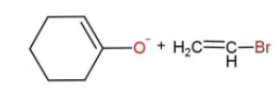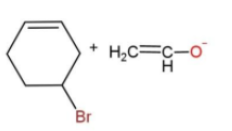
Answer
408k+ views
Hint: Williamson ether synthesis is a reaction which is used to prepare ethers. It uses an organohalide compound, which
is a compound that contains a halogen along with a carbon alkyl chain, which reacts with an alkoxide to yield ethers.
Complete answer:
Williamson synthesis for ethers involve a reaction sequence, where an alkoxide reacts with a alkyl halide through the mechanism of nucleophilic substitution reaction, which is a ${{S}_{N}}^{2}$ type of reaction. The alkoxide involved is usually a sodium alkoxide which is readily reduced to remove the sodium metal ion, the remaining is the alkoxide ion which is used in the reaction. The alkoxide ion replaces the nucleophile, bromine ion and forms an ether.
In the given reaction, the mechanism followed is ${{S}_{N}}^{2}$which is followed by inversion of configuration where the attacking nucleophile gets attached from the back side. So, reaction c favors this condition, as the removal of Br from the bulky group is easier also the alkoxide ion attacks from the opposite side to yield the product. While in other reactions, the alkoxide is the carbon ring, which does not get attached to the carbon chain due to its bulkiness, so the alkoxide attaching is favored.
The reaction is as follows:

Hence, option c is the correct way for ether synthesis.
Note:
The alkoxide is formed from the reaction of an alcohol with a metal ion. The metal ion is sodium preferably which is present as a base NaOH. The reaction uses the acidic nature of alcohols, and removes the hydrogen ion to form an alkoxide. This is the first step of Williamson ether synthesis.
is a compound that contains a halogen along with a carbon alkyl chain, which reacts with an alkoxide to yield ethers.
Complete answer:
Williamson synthesis for ethers involve a reaction sequence, where an alkoxide reacts with a alkyl halide through the mechanism of nucleophilic substitution reaction, which is a ${{S}_{N}}^{2}$ type of reaction. The alkoxide involved is usually a sodium alkoxide which is readily reduced to remove the sodium metal ion, the remaining is the alkoxide ion which is used in the reaction. The alkoxide ion replaces the nucleophile, bromine ion and forms an ether.
In the given reaction, the mechanism followed is ${{S}_{N}}^{2}$which is followed by inversion of configuration where the attacking nucleophile gets attached from the back side. So, reaction c favors this condition, as the removal of Br from the bulky group is easier also the alkoxide ion attacks from the opposite side to yield the product. While in other reactions, the alkoxide is the carbon ring, which does not get attached to the carbon chain due to its bulkiness, so the alkoxide attaching is favored.
The reaction is as follows:

Hence, option c is the correct way for ether synthesis.
Note:
The alkoxide is formed from the reaction of an alcohol with a metal ion. The metal ion is sodium preferably which is present as a base NaOH. The reaction uses the acidic nature of alcohols, and removes the hydrogen ion to form an alkoxide. This is the first step of Williamson ether synthesis.
Recently Updated Pages
Write the IUPAC name of the given compound class 11 chemistry CBSE

Write the IUPAC name of the given compound class 11 chemistry CBSE

Write the IUPAC name of the given compound class 11 chemistry CBSE

Write the IUPAC name of the given compound class 11 chemistry CBSE

Write the IUPAC name of the given compound class 11 chemistry CBSE

Write the IUPAC name of the given compound class 11 chemistry CBSE

Trending doubts
Fill the blanks with the suitable prepositions 1 The class 9 english CBSE

Which are the Top 10 Largest Countries of the World?

How do you graph the function fx 4x class 9 maths CBSE

Distinguish between the following Ferrous and nonferrous class 9 social science CBSE

The term ISWM refers to A Integrated Solid Waste Machine class 10 social science CBSE

The Equation xxx + 2 is Satisfied when x is Equal to Class 10 Maths

Difference between Prokaryotic cell and Eukaryotic class 11 biology CBSE

Which is the longest day and shortest night in the class 11 sst CBSE

In a democracy the final decisionmaking power rests class 11 social science CBSE









